The topic for the “Pressing” club debate was the enemy’s image in Armenia, Turkey and Azerbaijan. Editors of the political section of the “New Anatolia” Turkish paper Nursun Erel, as well as Azerbaijani journalists Alekper Aliev and Elmir Mirzoyev, were also participating in the debate. They had been invited by the “Caucasian Center for Peacemaking Initiatives” and the British Embassy of Armenia.
According to the host of the debate and vice-editor of “168 Hours” Armen Baghdasaryan, this is an actual topic in Armenia and Azerbaijan.
“Unfortunately, this has become modern in Turkey too and the Turkish presses have tried to create the image of an enemy after the French Senate’s bill approval.”
Baghdasaryan suggested not discussing where the process of creating the image of an enemy is more intensive, but rather whether or not it’s necessary to work towards that and why that image is created. Baghdasaryan also said that according to him, people misinterpret the image of the enemy with the propaganda of war calls and the war call propaganda is somewhat understandable for the countries with unresolved conflicts.
“But is the creation of the enemy’s image an important component? We all understand that there will be war call propaganda as long as the Karabakh conflict remains unresolved. But we’re creating obstacles for the future establishment of peace by creating that image today,” said Baghdasaryan.
He recalled an interview on the Azerbaijani “day.az” news website, in which some female Azerbaijani singer had said “it seems like they’re all Armenians” when talking about her colleagues at the theatre.
“What she meant to say is that it seems like they’re all enemies. This was not a political issue; it’s just that the words “Armenian” and “enemy” had been used as if they were synonyms.”
In other words, this serves as enough ground to create the image of an enemy among Armenians. Is it really necessary to fight against the enemy image or is it normal based on the war status?
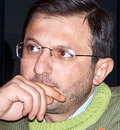 Gegham Manukyan (adviser for news/political programs for “Yerkir Media” TV and ARF National Assembly deputy) believes that it’s not necessary to fight against the enemy’s image, but rather not create it at all. According to him, one nation can’t be the enemy of another nation.
Gegham Manukyan (adviser for news/political programs for “Yerkir Media” TV and ARF National Assembly deputy) believes that it’s not necessary to fight against the enemy’s image, but rather not create it at all. According to him, one nation can’t be the enemy of another nation.
“The Turks can’t be enemies for the Armenians and vice versa. The same goes for Armenians and Azerbaijani.”
Manukyan said that he would like to see Azerbaijan grant Armenians the chance to express them freely, just like the Turk and Azerbaijani journalists had in Armenia.
“I would like to go to Azerbaijan and take an interview. However, when “Yerkir Media” television tried to go to Azerbaijan with help from international organizations and provide coverage of the elections in Azerbaijan two times, everyone simply said ‘that’s impossible.’”
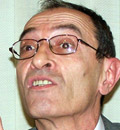 NA deputy Shavarsh Kocharyan began his speech by making a reference to the Armenian Constitution: “The use of rights and freedoms with the purpose of increasing national hatred, violence or propagandizing war is prohibited.” Mentioning that the same clause is stated in the Azerbaijani Constitution, Sh. Kocharyan tied the tolerance with the presence of a legitimate state.
NA deputy Shavarsh Kocharyan began his speech by making a reference to the Armenian Constitution: “The use of rights and freedoms with the purpose of increasing national hatred, violence or propagandizing war is prohibited.” Mentioning that the same clause is stated in the Azerbaijani Constitution, Sh. Kocharyan tied the tolerance with the presence of a legitimate state.
“If we were legitimate states, then we wouldn’t be having this discussion. If the principal law prohibits that, then what are we talking about?…The most important way to reach an environment of tolerance, our states must become legal.”
According to Sh. Kocharyan, the next important step is human relations.
“This debate is an example of normal human relations, but a unique and rare example…We political activists must do everything we can to organize debates often. We mustn’t think that all issues are solved like that. But the more we meet, at least we’ll start to communicate like normal human beings and that is very important.”
 Georgi Vanyan (member of the “Caucasian Center for Peacemaking Initiatives” NGO) agreed with the fact that it’s better to not create the image of the enemy rather than fighting against it. However, he believes that the image already exists. As proof of that, he mentioned how the rector of the Yerevan State University had prohibited Turk journalist Nursun Erel to meet with the students.
Georgi Vanyan (member of the “Caucasian Center for Peacemaking Initiatives” NGO) agreed with the fact that it’s better to not create the image of the enemy rather than fighting against it. However, he believes that the image already exists. As proof of that, he mentioned how the rector of the Yerevan State University had prohibited Turk journalist Nursun Erel to meet with the students.
“The rector tells “Aravot” newspaper that the university has an event scheduled. But he’s lying because he told us on the phone that the Turk should not step foot in the university. This says a lot about the enemy’s image,” says G. Vanyan. The latter also recalled the event at the “Atcharyan” university when the dean of the International Relations department had given a lecture to Erel and told her to behave herself. “And the audience claps, but it was about her expressed opinions. This is the sad part of it all because the future diplomats prepared by the so-called patriots aren’t going to be able to negotiate. That diplomat is going to give lectures about patriotism without even knowing the subject being talked about or how to negotiate.”
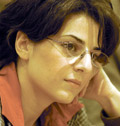 Seda Muradyan (Institute of Elucidation of War and Peace) tried to answer the question as to why the audience clapped after hearing the words “behave yourself”.
Seda Muradyan (Institute of Elucidation of War and Peace) tried to answer the question as to why the audience clapped after hearing the words “behave yourself”.
“Years ago, when the march with torches to the Genocide Memorial and museum took place, a group of young people were trying to burn the Turkish flag. The police took the flag and didn’t allow them to do that. But today we can see on television how that flag is burnt during the march. I think that this has an influence on the sub-consciousness of Armenian society and leads to the applause of the youth when they hear the expression “behave yourself”.”
Muradyan is certain that the fight against the image of the enemy must begin at an early age when children are in school.
“Today there are schools in Armenia where children take military classes. If you take a look at the teacher’s textbook, then you will see where Armenia is headed towards with that knowledge, which tries to educate future enemies.”
 As for Nursun Erel, whom the Yerevan State University rector had forbidden to meet with the students, it turns out that she didn’t care as much as her Armenian colleagues did.
As for Nursun Erel, whom the Yerevan State University rector had forbidden to meet with the students, it turns out that she didn’t care as much as her Armenian colleagues did.
“I would like to say that there were a couple of daring YSU students, who approached me and we worked effectively.”
According to her, frequent meetings are one of the best ways to fight against the enemy’s image.
“We have to meet more frequently, cooperate, exchange ideas regarding different issues. I’m certain that only by doing this will we be able to free ourselves from the enemy’s image because Turkey has the same problem with Greece,” says N. Erel.
 Publicist Vahram Martirosyan believes that Armenians must compare themselves using the values that are really important. According to V. Martirosyan, the enemy’s image is going through “modernization”.
Publicist Vahram Martirosyan believes that Armenians must compare themselves using the values that are really important. According to V. Martirosyan, the enemy’s image is going through “modernization”.
“Armenians imagined an enemy 20 years ago, for example, the Iranians who had attacked Armenia in 451 A.D. I remember when I was a child; I would always wonder when Armenia would be able to get revenge. Now it’s not like that.”
There were some opinions, claiming that the Azerbaijani and Turkish presses misinterpret the information and don’t present the speeches of Armenian government officials and others word for word. With that said, V. Martirosyan is certain that it’s very important to prepare normal news programs which, in turn, will help Azerbaijan.
“However, I know for a fact that nothing will change in Azerbaijan anytime soon. But we Armenians shouldn’t feel good about ourselves that there is dictatorship in Azerbaijan. We shouldn’t draw comparisons, find errors on the information on the Web and be pleased about that. Let’s talk about the errors that we can correct,” said V. Martirosyan as he called on the guests.
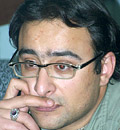 Journalist Alekper Aliev had this to say to V. Martirosyan:
Journalist Alekper Aliev had this to say to V. Martirosyan:
“There is no dictatorship in Azerbaijan. Azerbaijan is a democratic republic.”
Some debaters laughed after hearing this statement, but Aliev replied:
“Why are you laughing? I’m serious. There is no totalitarianism in Azerbaijan; everything is fine.”
However, Aliev himself laughed at some things during his speech.
“The thing is that in Azerbaijan, and perhaps the entire Southern Caucasus region, everything exists based on phoniness and pseudo. I consider all organizations phony. Everything is ridiculous in Azerbaijan. The Academy of Sciences, the university, state structures…they are all ridiculous. I laugh at all that. When I see someone, including an Armenian, treat that seriously, I laugh at that too. I would like to emphasize that the entire Southern Caucasus is ridiculous,” said A. Aliev.
 Publicist Tigran Paskevichyan is of the opinion that the “enemy’s image” doesn’t exist at all.
Publicist Tigran Paskevichyan is of the opinion that the “enemy’s image” doesn’t exist at all.
“In reality, sociologists came up with the image of the enemy in order to organize seminars and debates. We can call that some kind of social or political “elite” phenomenon, which deals with the image of the enemy.”
Tigran Paskevichyan mentioned that as you talk with the Armenian villagers living on the border, you realize that none of them knows what “image of the enemy” means.
“They feel that they are on the border, which splits the Armenians and the Azerbaijani. They see the image of the lost friends, which causes confusion among people…If we don’t create that image, it really doesn’t exist. It turns out that we are fighting against something that we create ourselves.”
The publicist also placed emphasis on the fact that Armenians must stop pretending to be patriotic because that’s how the image of the enemy is created in the first place.
“When someone in Azerbaijan prints a book, places the picture of the Armenian Garni temple and writes that that temple is a Western Azerbaijani monument, that makes Armenians laugh, but in reality that Azerbaijani writer is hurting his own people.”
According to Paskevichyan, Armenia’s goal is not to find out who, whom, how many times or what this person said to the other; the goal is to recognize and understand each other. With that said, he called on the Azerbaijani and Turk journalists to let Armenians also have the chance to express themselves in Azerbaijan.
Chief Editor of “168 Hours” newspaper Satik Seyranyan also talked about the issue concerning cooperation.
“ “168 Hours” used to work with the “Region” center. We asked our Georgian and Azerbaijani colleagues to prepare a series of articles on that topic. We decided to have three journalists from Georgia, Armenia and Azerbaijan meet each other on the border coming from Sadakhlo. In the end, the Azerbaijani journalist refused to have the article printed on behalf of him and it was signed by the Georgian journalist instead. After that we suggested the second topic, but we didn’t reach success because of the Azerbaijani side,” said S. Seyranyan.
Seyranyan informed that “168 Hours” prints some Azerbaijani and Turkish news, sometimes even anti-Armenian as simply information. However, the Azerbaijani refuse to cooperate most of the time.
 Publicist Elmir Mirzoyev advised leaving the Southern Caucasus region alone for a while. According to him, mutual love between nations is impossible, even in European countries.
Publicist Elmir Mirzoyev advised leaving the Southern Caucasus region alone for a while. According to him, mutual love between nations is impossible, even in European countries.
“It’s simply kept a secret and the political establishment doesn’t allow that, so that things don’t get heated up.”
Mirzoyev believes that the decisions made by the given country’s authorities play a more decisive role than the opinions of the society.
Mirzoyev’s colleague, Alekper Aliev, found it necessary to mention that Azerbaijani journalists and NGO representatives are never pressured by Azerbaijani authorities upon their return to Azerbaijan from Armenia.
“They don’t call us to the police station, or the National Security Services, or sue us. But some phony journalists, TV channels and NGOs start spreading the wrong information. Those people are offending us and throwing dirt in our eyes. The authorities see that; they see what’s going on. They don’t care where we go. However, at the same time, they don’t let others throw stones at us. That’s why you begin to doubt the phoniness of state structures.”
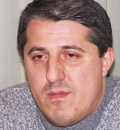 According to Vartan Voskanyan (Eastern Studies expert, Yerevan State University), you can’t revise history from another perspective, even with good intentions. In other words, if people turn the dark pages of history and only talk about the good things, that won’t help. V. Voskanyan claims that it’s all about the inner ethics.
According to Vartan Voskanyan (Eastern Studies expert, Yerevan State University), you can’t revise history from another perspective, even with good intentions. In other words, if people turn the dark pages of history and only talk about the good things, that won’t help. V. Voskanyan claims that it’s all about the inner ethics.
“All Armenians have read writer Raffi’s works and they can read in all history books that the Persians attacked Armenia in 451 A.D. But today, no Armenian even thinks about killing any Iranian for that,” says Iranian Studies specialist V. Voskanyan.
While discussing the image of the enemy, Voskanyan mentioned that most of the Iranians that visit Armenia speak Azerbaijani.
“When the Iranian says “yakhshi”, Armenians know that that’s not Persian, but they don’t say anything to him.”
The Iranian Studies specialist explains that the problem doesn’t deal with ethnic conflicts, but rather Azerbaijan.

